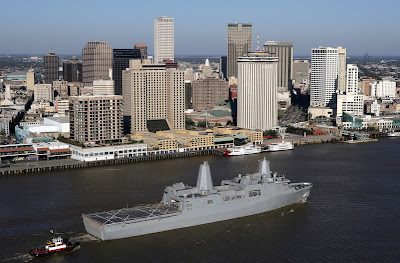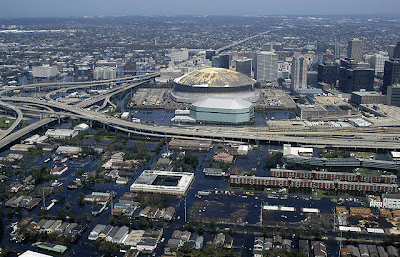"Laissez les bons temps rouler" is what they say here in the Big Easy, and you also can "let the good times roll" with the cool Bourbon Street, a Dixieland band hot, and even hotter Creole cuisine. Mardi Gras may be the calling card of town, but it's only one day of the year is hot and humid in New Orleans.
Please, take the operation down the Mississippi, chew some beignets, and watch the Saints go marchin 'in. But when it's time to go, you'll also know what it means to miss New Orleans.
 |
| New Orleans Image Credit : wikipedia.org |
Famous festivals such as Mardi Gras and Jazz Fest bring in tourists by the millions, and the two times of year when one needs to be sure to book well in advance to ensure a space. The city also hosts a variety of smaller festivals and gatherings like the French Quarter Festival, Creole Tomato Festival, Satchmo SummerFest, Essence Festival hosted by the magazine, and a showcase Halloween costume ball, Day Saint Patrick and Saint Joseph's Day showcase, Southern Decadence, and so many again. This city takes almost every opportunity for an excuse to parade, party, and live music, and events in New Orleans most often have a touch of Mardi Gras all year round. As they say, a good New Orleanians are planning a party, enjoying one or recovering from one. Under the party!
 |
| A view of the New Orleans Central Business District as seen from the Mississippi River. Image Credit : wikipedia.org |
A British attempt to capture the city in 1815 was rejected downstream of the city in Chalmette by local forces led by Andrew Jackson, whose equestrian statue can be seen in the main square in the old city center called Quarter.
Early New Orleans is a rich melting pot of people and cultures. French Spanish and African immigrants from joining Anglo Irish, German, and the Caribbean. While the center of the slave trade before the American Civil War, New Orleans USA also has the largest population of free people of color. The city grew rapidly as a major trading center on the mighty Mississippi River. In the American Civil War of the 1860s, New Orleans fell to the Union early in the conflict without fighting in the city, sparing the rich historical architecture of the destruction suffered by many South Americans.
In the early 20th century, largely ignored the old French Quarter began to gain a new appreciation among artists and bohemians for its architecture and atmosphere. Around the same time, a new music style that developed in the city, and the music swept across the developed world with the name "jazz".
Although far from major battlefronts, New Orleans is proud of contributing to the Allied victory over fascism in World War II, particularly the development and construction of landing craft such as the "Higgins Boats" which makes the mass landing of troops in hostile shore quickly as possible. This legacy is why the National World War II Museum is located in the city of America.
 |
| An aerial view from a United States Navy helicopter showing floodwaters around the Louisiana Superdome and surrounding area Image Credit : wikipedia.org |
New Orleans was not destroyed, but the flooding was a major blow, perhaps the worst disaster to hit a major U.S. city since the San Francisco earthquake 99 years earlier. Almost 8 years later, many visitors may see little or no signs that something bad happened. For locals, however, in many parts of the city rebuild is still an ongoing process. The French Quarter and other parts of the city's oldest most popular with visitors comparative built on high ground, and damaged less and have more quickly restored. However, not everything is back to normal in the city, scenes of devastation can still be seen in many environments. More than two-thirds of the pre-Katrina population of the city is back living in the city, most of them have a fierce love of their city and have faced many difficulties in their efforts to continue to rebuild little by little.
Public service in this city - especially the police - has struggled to get back to their full strength, and dealing with a city where decades of stability of the environment has been disturbed. The city as a whole has experienced an increase in crime as a result. (See "Stay safe" below.)
While some visitors decide to limit their travel to the more fully intact from the city or just visiting the area badly hit as part of a half-day "disaster tour", for others a historic event Katrina and consequently is the focus of their visit.
Volunteer projects such as "New Orleans Area Habitat for Humanity" is building a new house has attracted volunteers doing a good job. Organizations such as Levees.org vigilant in encouraging further investigation into the flood and hurricane protection issues around New Orleans, and visitors to the city are encouraged to tour the damaged areas and help keep alive the attention that is needed to restore New Orleans to its original splendor.
 |
| Hurricane Katrina at its New Orleans landfall. Image Credit : wikipedia.org |
The oldest aspects of New Orleans culture is a Creole-which here refers the people who have been here before the city became part of the United States with the Louisiana Purchase in 1803. France, Spain, and Africa is a major cultural and ethnic groups in the old Creole culture, with additional input from Native Americans and early German immigrants (which became far more later in the 19th century).
Since the Louisiana Purchase, the other major immigrant groups and the influence on the local cuisine and culture have been included Italian (mostly the South and Sicily), Ireland, Germany, the Caribbean and Central America. Honduras has traditionally been the largest Hispanic group in the metro area, but after Katrina, now there is the inclusion of Latinos, mostly from Mexico and Central America who have decided to stay after helping in post-Katrina construction boom. Smaller population of Cubans, Dominicans, and Puerto Rico also disekujur area. At the end of the 20th century a sizable Vietnamese community have been added to the New Orleans gumbo. They can be found in the highest concentration in New Orleans East and suburban Westbank (Marrero, Harvey, & Gretna).
Posted by , Published at 1:10 PM and have
1 comments
I have never been there before, but i have checked the information from http://attractions.bz, but the details of it is not complete, there just some official information, not the feeling of one person.
ReplyDeleteThank you for sharing this, now i am prepare to go there, hope i will have a unforgettable trip, have a good day!!!